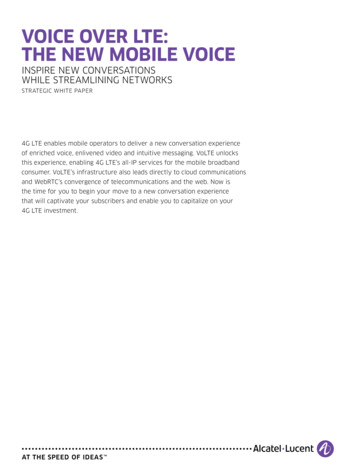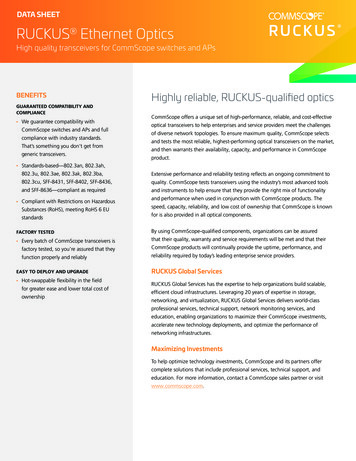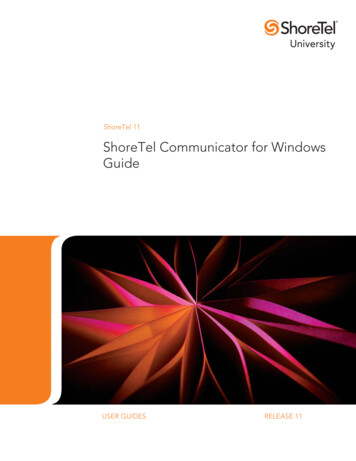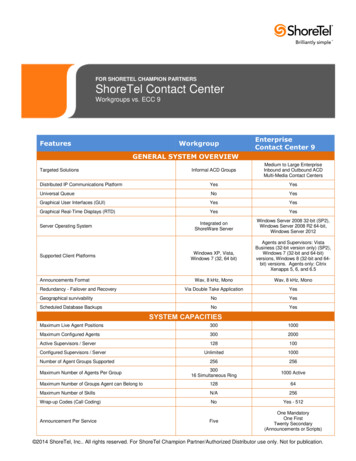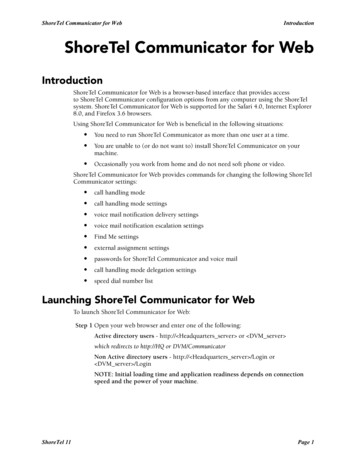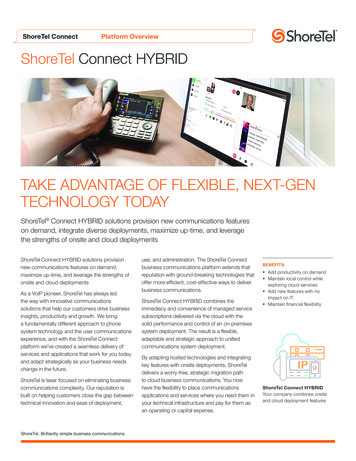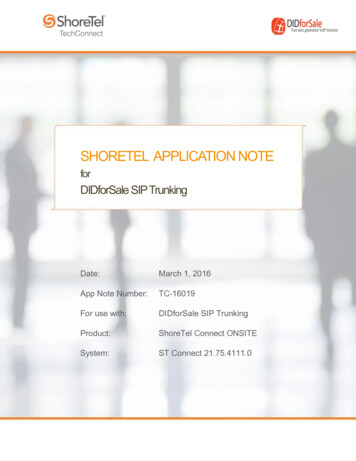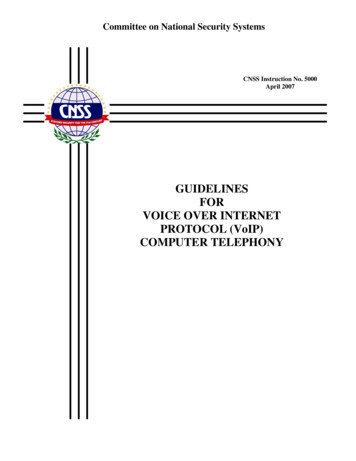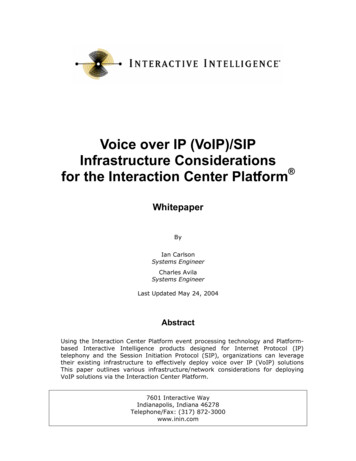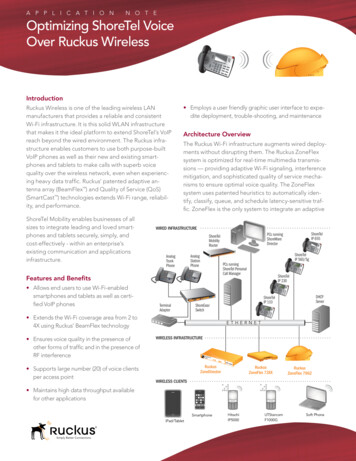
Transcription
applicati o nn o teOptimizing ShoreTel VoiceOver Ruckus WirelessIntroductionRuckus Wireless is one of the leading wireless LANmanufacturers that provides a reliable and consistentWi-Fi infrastructure. It is this solid WLAN infrastructurethat makes it the ideal platform to extend ShoreTel’s VoIPreach beyond the wired environment. The Ruckus infrastructure enables customers to use both purpose-builtVoIP phones as well as their new and existing smartphones and tablets to make calls with superb voicequality over the wireless network, even when experiencing heavy data traffic. Ruckus’ patented adaptive antenna array (BeamFlex ) and Quality of Service (QoS)(SmartCast ) technologies extends Wi-Fi range, reliability, and performance.ShoreTel Mobility enables businesses of allsizes to integrate leading and loved smartphones and tablets securely, simply, andcost-effectively - within an enterprise’sexisting communication and applicationsinfrastructure. Employs a user friendly graphic user interface to expedite deployment, trouble-shooting, and maintenanceArchitecture OverviewThe Ruckus Wi-Fi infrastructure augments wired deployments without disrupting them. The Ruckus ZoneFlexsystem is optimized for real-time multimedia transmissions — providing adaptive Wi-Fi signaling, interferencemitigation, and sophisticated quality of service mechanisms to ensure optimal voice quality. The ZoneFlexsystem uses patented heuristics to automatically identify, classify, queue, and schedule latency-sensitive traffic. ZoneFlex is the only system to integrate an adaptiveWIRED INFRASTRUCTUREAnalogTrunkPhoneAnalogStationPhone Allows end users to use Wi-Fi-enabledsmartphones and tablets as well as certified VoIP phonesTerminalAdapter Supports large number (20) of voice clientsper access pointShoreTelIP 230DHCPServerShoreTelIP 110ShoreGearSwitch Extends the Wi-Fi coverage area from 2 to4X using Ruckus’ BeamFlex technology Ensures voice quality in the presence ofother forms of traffic and in the presence ofRF interferenceShoreTelIP 560/5gPCs runningShoreTel PersonalCall ManagerFeatures and BenefitsShoreTelIP 655PCs RNETWIRELESS INFRASTRUCTUREZoneDirec3000 torRuckusZoneDirectorRuckusZoneFlex 73XXRuckusZoneFlex 7962WIRELESS CLIENTS Maintains high data throughput availablefor other arcomF1000GSoft Phone
Optimizing ShoreTel Voice Over Ruckus WirelessApplication Notemulti-element antenna array within each access point, providing four queues for each client device, ensuring airtimefairness and consistent performance.Requirements, Certification and LimitationsThe Ruckus Wireless infrastructure is a self-contained (appliance) system. To operate, it requires a standard networking environment that includes an Ethernet switch to plug into and Dynamic Host Configuration Protocol (DHCP) server to allocateaddresses. Specific certifications required to operate in particular countries are available directly from Ruckus Wireless.Version SupportZoneDirector9.1.1.0 build 55ShoreTel Release11.23Certification Testing Results SummaryTable 1: Basic Test essful bring-up from power-up to a state where clients can associate andpass traffic through the AP.PASS1.2ResetSuccessful re-initialization of device after power lossPASS1.3Verify correct voiceclassificationVerify that voice settings match PBX TOS settings and voice traffic is assignedhigh priorityPASS1.4Place callVerify successful call placement with normal dialing to a variety of terminatingphonesPASSTable 2: ShoreTel Mobility Router Test CasesIDName2.12.2Mobile Device toPSTNDescriptionResultsMake an outgoing call from the Mobile Device while on Wi-Fi. Verify that acall can be completedPASSMake an outgoing call using from the Mobile Device while on cell. Verify thatthe call can be completed.PASS2.3Mobile Device toLocal Desk PhoneMake an outgoing call using from the Mobile Device while on cell. Verify thatthe call can be completed.PASS2.4PSTN to MobileDeviceReceive an incoming call while the Mobile Device is on Wi-Fi. Verify that thecall can be completed.PASSReceive an incoming call while the Mobile Device is on cell. Verify that thecall can be completed.PASSMake a call while on Wi-Fi. Exit the Wi-Fi area and verify call continuity fromWi-Fi to cellular.PASSMake a call while on cell. Enter into the Wi-Fi area and verify call continuityfrom cellular to Wi-FiPASSReceive a call while on Wi-Fi. Exit the Wi-Fi area and verify call continuityfrom Wi-Fi to cellular.PASSReceive a call while on cell. Enter into the Wi-Fi area and verify call continuityfrom cellular to Wi-FiPASSMake a call to the Mobile Device using extension dialing while the user is oncellular. Verify that the call is received while on cellularPASSMake a call to the Mobile Device using extension dialing while the user is onWi-Fi. Verify that the desk phone and cellular phone simultaneously ring.PASS2.52.6Mobile Device toPSTN (roaming)2.72.8PSTN to MobileDevice (roaming)2.92.102.11One NumberOptimizing ShoreTel Voice Over Ruckus WirelessPage 2
Optimizing ShoreTel Voice Over Ruckus WirelessApplication NoteIDNameDescriptionResults2.12Calling Line IDFrom the Mobile Device on Wi-Fi, make an external call out through the PSTN.Verify that the calling line ID appears to be the enterprise number.PASSFrom the Mobile Device on cellular, make an external call out through the PSTN.Verify that the calling line ID appears to be the enterprise number.PASS2.132.14Call ForwardingFrom the Mobile Device preferences screen, enable call forward to PSTNendpoint. Make a call to the Mobile Device from PSTN. Verify that the call nowarrives at the forwarded number.PASS2.15Do Not DisturbFrom the Mobile Device, preference screen, enable DND. Make a call to theMobile Device from PSTN. Verify that the call goes to voicemail.PASS2.16Transfer to DeskMake call from PSTN to Mobile Device on Wi-Fi. While the call is on Wi-Fi,transfer the call to the desk phone (in the Options Menu). Verify that the call nowcan be taken from the desk phone and the cell phone line is no longer active.PASS2.17Make call from PSTN to Mobile Device on cell. While the call is on cell, transferthe call to the desk phone (in the Options Menu). Verify that the call now can betaken from the desk phone and the cell phone line is no longer active.PASS2.18While on a Wi-Fi call (PSTN handover), select mute. Ensure that the line is nowmuted.PASS2.19MuteWhile on a cell call (PSTN handover), select mute. Ensure that the line is nowmuted.PASS2.20Mobile Device (Wi-Fi)to PSTNPut on hold, wait 10 sec, take off of holdPASS2.21Mobile Device (cell) toPSTNPut on hold, wait 10 sec, take off of holdPASS2.22PSTN to MobileDevice (Wi-Fi)Put on hold, wait 10 sec, take off of holdPASS2.23PSTN to MobileDevice (cell)Put on hold, wait 10 sec, take off of holdPASS2.24Mobile Device (Wi-Fi)to PSTNWhile on a Wi-Fi call, transfer the call to another extension. Verify successfultransfer of the call.PASS2.25Mobile Device (cell) toPSTNWhile on a cell call, transfer the call to another extension. Verify successfultransfer of the call.PASS2.26PSTN to MobileDevice (Wi-Fi)While on a Wi-Fi call, transfer the call to another extension. Verify successfultransfer of the call.PASS2.27PSTN to MobileDevice (cell)While on a cell call, transfer the call to another extension. Verify successfultransfer of the call.PASS2.28Call SwapEnsure that two calls (PSTN to Mobile Device and PSTN to Mobile Device) canbe received on the Mobile Device while in Wi-Fi mode. On BlackBerry, calls mayNOT be swapped between cellular and Wi-Fi lines – the cellular call must becompleted in order to return to the Wi-Fi call.PASS2.29Mobile Device (Wi-Fi)to PSTNWhile on a Wi-Fi call,conference the call with another extension. Verify successfulconference of the call.PASS2.30Mobile Device (Wi-Fi)to PSTNWhile on a cell call, conference the call with another extension. Verify successfulconference of the call.PASS2.31Mobile Device (Wi-Fi)to PSTNWhile on a Wi-Fi call, conference the call with another extension. Verify successfulconference of the call.PASS2.32Mobile Device (cell) toPSTNWhile on a cell call, conference the call with another extension. Verify successfulconference of the call.PASSOptimizing ShoreTel Voice Over Ruckus WirelessPage 3
Optimizing ShoreTel Voice Over Ruckus WirelessApplication NoteIDNameDescriptionResults2.33Voice mailLeave a voicemail for the Mobile Device using PSTN.PASS2.34Ensure that voicemail may be retrieved using the short key. Retrieve voice mailwhile on Wi-Fi.PASS2.36Ensure that voicemail may be retrieved using the short key. Retrieve voice mailwhile on cell.PASS2.37Leave voice mail for another extension while on Wi-Fi.PASS2.38Leave voice mail for another extension while on cell.PASSEnsure that the voicemail icon appears when a voicemail has been left in theenterprise voice mailbox. Verify that the voicemail icon disappears after thevoicemail has been retrieved.PASS2.39Message WaitingIndicatorTable 3: Extended Feature Test CasesIDNameDescriptionNotes3.1Call waitingVerify appropriate notification and successful connection of incoming call whilebusy with another partyPASS3.2ParkVerify successful park and retrieval of connected callPASS3.3Extended forwardVerify extended call forwarding options – busy forwarding, no-answer forwardingPASS3.5Transfer – blindVerify successful blind transfer of connected callPASS3.6Transfer – monitoredVerify successful monitored transfer of connected callPASS3.7Conference – ad hocVerify successful ad hoc conference of three partiesPASSConfiguration OverviewShoreTel ConfigurationThe Ruckus ZoneFlex Quick Start Guide (available online at ns the set up/configuration information for theZoneFlex Product Suite.It is assumed that the ShoreTel IP PBX and the ShoreTelMobility Router are configured and otherwise fullyoperational.The Ruckus administration server requires Windows XP/Service Pack 2-equipped PC with Sun Java RuntimeEnvironment (v5 or later) installed.; and the Web browsershould be either Internet Explorer (v6 or later) or MozillaFirefox (v1.4 or later). The ZoneDirector’s IP address, netmask, gateway and Domain Name System (DNS) serveraddresses assigned — must be identified if it has a staticnetwork address.Optimizing ShoreTel Voice Over Ruckus WirelessTo ensure interoperability, the TOS setting used to classifyvoice traffic should match between the ShoreTel IP PBX andthe Ruckus networking infrastructure. The Wi-Fi alliancerecommendations for Differentiated Services Code Point(DSCP) settings are: (see Table 4 on the following page)Page 4
Optimizing ShoreTel Voice Over Ruckus WirelessApplication NoteTable 4: Recommended DSCP to 802.1d mapping (based on 3.3.1 of WMM specifications)DSCP p2DSCP p1DSCP p0DSCP —DSCP —DSCP —DSCP hex802.1dWMM AC1110000x387AC VO1100000x306AC VO1010000x285AC VI1000000x204AC VI0110000x183AC BE0100000x102AC BK0010000x081AC BK0000000x000AC BEAs seen in the table above, for voice priority (AC VO), the recommended DSCP setting is 0x38 or 0x30, which translates toa TOS setting of 0xE0 or 0xC0.A Ruckus AP will automatically classify traffic with a TOS marking of 0xE0 or 0xC0 for voice queue and a video queue of0xA0 or 0x80. If traffic is not TOS marked (i.e. TOS 0), heuristic classification will attempt to automatically classify the trafficby its patterns.TOS is configured on the ShoreTel IP PBX through the ShoreWare Director, navigate to Administration Call Control Options, as illustrated below. Since the numbers are in decimal, the TOS should be configured for 192 or 224.Optimizing ShoreTel Voice Over Ruckus WirelessPage 5
Optimizing ShoreTel Voice Over Ruckus WirelessApplication NoteShoreTel Mobility RouterRuckus Wireless Technical SupportThe ShoreTel Mobility Router (SMR) connects to theShoreTel IP PBX using both line-side mode (for internalWi-Fi calls) and trunk-side mode (for cell calls via the SMRenterprise access and handover numbers. Features thatthis topology will support includes short number dialing,automatic, (sub-100 msec) handover between Wi-Fi andcellular networks, call forwarding, three-way conferencing, music on hold, RoamAnywhere Dual Persona , SecureRemote Voice, Secure Enterprise Services, remote overthe-air provisioning, simultaneous ring of the desk phoneand dual-mode devices. Additionally, the SMR registers tothe ShoreGear switch on the SIP line side as a SIP Extensionon behalf of each of the mobile users.Self-support via the Ruckus Support Web is at http://support.ruckuswireless.com. This site contains a comprehensive set of information including product manuals, technicaldocuments and software updates. Technical support froma Ruckus Technical Support Engineer is available via phoneor email. Telephone Support is provided to customers whohave purchased any of the Ruckus Support packages.Note: Refer to the ShoreTel Mobility Router SolutionPlatform Supportability Guide for more information onsupported handsets. http://www.shoretel.com/products/user apps/roamanywhere client/handsetsSupport contact information:Worldwide: 1-650-265-0903Email: support@ruckuswireless.comShoreTel, Inc.960 Stewart DriveSunnyvale, California 94085 USA 1.408.331.3300 1.408.331.3333 faxRuckus Wireless Configuration andTroubleshootingRelease Notes and User Guides are available online at:ZoneDirector 1100 Series: director-1100ZoneDirector 3000 Series: director-3000ZoneFlex 9.1 AP User Guide: neflex-release-9-1-ap-user-guideZoneFlex 7962 802.11n Access Point: flex-7962ZoneFlex 7363 802.11n Access Point: flex-7363Ruckus Wireless, Inc.880 West Maude Avenue, Suite 101, Sunnyvale, CA 94085 USA(650) 265-4200 Ph \ (408) 738-2065 FxCopyright 2011, Ruckus Wireless, Inc. All rights reserved. Ruckus Wireless and Ruckus Wireless design are registered in the U.S. Patent and TrademarkOffice. Ruckus Wireless, the Ruckus Wireless logo, BeamFlex, ZoneFlex, MediaFlex, FlexMaster, ZoneDirector, SpeedFlex, SmartCast, and Dynamic PSKare trademarks of Ruckus Wireless, Inc. in the United States and other countries. All other trademarks mentioned in this document or website are theproperty of their respective owners. 805-71766-001 rev 01w w w.r u c k u s w i re le s s .co m
ShoreTel Configuration It is assumed that the ShoreTel IP PBX and the ShoreTel Mobility Router are configured and otherwise fully operational. To ensure interoperability, the T oS setting used to classify voice traffic should
